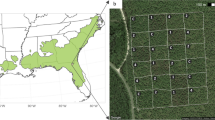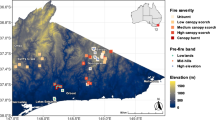Abstract
We conducted a census of the rare pine, Pinus torreyana ssp. torreyana, to determine (a) its population size and whether it is stable, growing, or declining; (b) the spatial variation in population structure; (c) the spatial patterning of trees in different life stages; and (d) the environmental factors that are related to seedling recruitment. Trees were classified into four stage classes: adult (>160 cm tall with cones); sub-adult (>160 cm without cones); saplings (30–160 cm); and seedlings (<30 cm). Stem diameter was measured for adults and sub-adults, and height for saplings and seedlings. Stands were defined by spatial clustering of the tree map. Univariate and bivariate point pattern analyses were used to explore spatial patterns for adult and juvenile trees and identify potential stand development processes such as density dependence, dispersal limitations, and patchy recruitment. Logistic regression was used to analyze seedling establishment and survival in relation to environmental variables derived from digital maps. Earlier studies reported little or no recruitment. We mapped 5,394 individuals, and tree size had “reverse J-shaped” distribution suggestive of a recruiting population. However, population structure was variable among stands. The predominant spatial pattern detected for adult and juvenile trees was clustering at lag distances <10 m. Bivariate pattern analysis did not suggest repulsion between adult and juvenile size classes. Seedlings tended to be found close to adults and on certain soil types. This suggests that the clustered patterns resulting from patchy recruitment of juveniles persist over time.







Similar content being viewed by others
References
Baddeley A, Turner R, Moller J, Hazelton M (2005) Residual analysis for spatial point processes. J R Stat Soc Ser B Stat Methodol 67:617–651
Biondi F, Cayan DR, Berger WH (1997) Dendroclimatology of Torrey pine (Pinus torreyana Parry ex Carr.). Am Midl Nat 138:237–251
Borchert M, Johnson M, Schreiner DS, Wall SBV (2003) Early postfire seed dispersal, seedling establishment and seedling mortality of Pinus coulteri (D. Don) in central coastal California, USA. Plant Ecol 168:207–220
Camarero JJ, Gutierrez E, Fortin MJ, Ribbens E (2005) Spatial patterns of tree recruitment in a relict population of Pinus uncinata: forest expansion through stratified diffusion. J Biogeogr 32:1979–1992
Cario AJ (1996) Seedling establishment in the rare Torrey Pine the role of substrate, competition, and microhabitat. M.S. Thesis, San Diego State University
Clark DA, Clark DB (1984) Spacing dynamics of a tropical rain forest tree: evaluation of the Janzen-Connell model. Am Nat 124:769–788
Cole KL, Wahl E (2000) A late Holocene paleoecological record from Torrey Pines State Reserve, California. Quat Res 53:341–351
Condit R, Ashton PS, Baker P, Bunyavejchewin S, Gunatilleke S, Gunatilleke N, Hubbell SP, Foster RB, Itoh A, LaFrankie JV, Lee HS, Losos E, Manokaran N, Sukumar R, Yamakura T (2000) Spatial patterns in the distribution of tropical tree species. Science 288:1414–1418
Diggle P (1983) Statistical analysis of spatial point patterns. Academic Press, London
ESRI (2007) ArcInfo users guide. Environmental Systems Research Institute, Redlands
Fortin MJ, Dale MRT (2005) Spatial analysis: a guide for ecologists. Cambridge University Press, Cambridge
Franklin J (2010) Spatial point pattern analysis of plants. In: Rey SJ, Anselin L (eds) Perspectives on spatial data analysis. Springer, New York, pp 113–123
Goreaud F, Pélissier R (2003) Avoiding misinterpretation of biotic interactions with the intertype K12-function: population independence vs. random labeling hypotheses. J Veg Sci 14:681–692
Haller JR (1986) Taxonomy and relationships of the mainland and island populations of Pinus torreyana (Pinaceae). Syst Bot 11:39–50
Harper JL (1977) Population biology of plants. Academic Press, London
Johnson M, Wall SBV, Borchert M (2003) A comparative analysis of seed and cone characteristics and seed-dispersal strategies of three pines in the subsection Sabinianae. Plant Ecol 168:69–84
Keith DA (2000) Sampling designs, field techniques and analytical methods for systematic plant population surveys. Ecol Manag Restor 1:125–139
Kenkel NC (1988) Pattern of self-thinning in Jack Pine: testing the random mortality hypothesis. Ecology 69:1017–1024
Knowles P, Grant MC (1983) Age and size structure analyses of Engelmann spruce, ponderosa pine, lodgepole pine, and limber pine in Colorado. Ecology 64:1–9
Lanner R (1998) Seed dispersal in Pinus. In: Richardson D (ed) Ecology and biogeography of Pinus. Cambridge University Press, Cambridge, pp 281–295
Ledig FT, Conkle MT (1983) Gene diversity and genetic structure in a narrow endemic, Torrey pine (Pinus torreyana Parry ex Carr.). Evolution 37:79–85
McCabe GP, Moore DS (2006) Introduction to the practice of statistics. WH Freeman, New York
McDonald RI, Peet RK, Urban D (2003) Spatial pattern of Quercus regeneration limitations and Acer rubrum invasion in a Piedmont forest. J Veg Sci 14:441–450
McMaster GS (1980) Patterns of reproduction in Torrey pine (Pinus torreyana). M.S. Thesis, San Diego State University, San Diego, CA
Moore I, Grayson R, Ladson A (1991) Digital terrain modelling: a review of hydrological, geomorphological, and biological applications. Hydrol Process 5:3–30
Newton AC (2007) Forest ecology and conservation: a handbook of techniques. Oxford University Press, Oxford
Noss RF (1999) Assessing and monitoring forest biodiversity: a suggested framework and indicators. For Ecol Manag 115:135–146
Ord JK, Getis A (1995) Local spatial autocorrelation statistics: distributional issues and an application. Geogr Anal 27:286–306
Palmiotto PA, Davies SJ, Vogt KA, Ashton MS, Vogt DJ, Ashton PS (2004) Soil-related habitat specialization in dipterocarp rain forest tree species in Borneo. J Ecol 92:609–623
Pélissier R, Goreaud F (2001) A practical approach to the study of spatial structure in simple cases of heterogeneous vegetation. J Veg Sci 12:99–108
Perry G, Miller B, Enright N (2006) A comparison of methods for the statistical analysis of spatial point patterns in plant ecology. Plant Ecol 187:59–82
Pielou EC (1977) Mathematical ecology. Wiley, New York
Quinn GP, Keough MJ (2002) Experimental design and data analysis for biologists. Cambridge University Press, Cambridge
R Development Core Team (2007) R: a language and environment for statistical computing. R Foundation for Statistical Computing, Vienna, Austria
Ripley BD (1981) Spatial statistics. Wiley, New York
Santos EV (2009) Population trends and recruitment patterns of Pinus torreyana at the Torrey Pines State Reserve. San Diego State University, San Diego
Schemske DW, Husband BC, Ruckelshaus MH, Goodwillie C, Parker IM, Bishop JG (1994) Evaluating approaches to the conservation of rare and endangered plants. Ecology 75:585–606
Schonher T, Nicholson SE (1989) The relationship between California rainfall and ENSO events. J Clim 2:1258–1269
Shea P, Neustein M (1995) Protection of a rare stand of Torrey pine from Ips paraconfusus. Application of semiochemicals for management of brak beetle infestations—Proceedings of an Informal Conference USDA, Forest Service. General Technical Report INT: GTR-318, pp 123–456
Shi H, Zhang LJ (2003) Local analysis of tree competition and growth. For Sci 49:938–955
Thompson B (1985) Seedling morphological evaluation—what you can tell by looking. In: Durvea ML (ed) Evaluating seedling quality: principles, procedures and predictive abilities of major tests. Workshop proceedings, Oct 1984, Forest Research Laboratory, Oregon State University, Corvallis, pp 59–71
Thompson SK (1992) Sampling. Wiley, New York
Wells ML, Getis A (1999) The spatial characteristics of stand structure in Pinus torreyana. Plant Ecol 143:153–170
Youngblood A, Max T, Coe K (2004) Stand structure in eastside old-growth ponderosa pine forests of Oregon and northern California. For Ecol Manag 199:191–217
Acknowledgments
This study was supported in part by the Torrey Pines Association. We thank D. Smith, California State Parks, J. Kummer, TPSR, and D. Deutschman and L. Beck, San Diego State University. L. Hierl, F. Bozzolo, and K. Valenti assisted us in the field work. L. Zelus also helped us immeasurably in the field and with many aspects of this project.
Author information
Authors and Affiliations
Corresponding author
Electronic supplementary material
Below is the link to the electronic supplementary material.
Rights and permissions
About this article
Cite this article
Franklin, J., Santos, E.V. A spatially explicit census reveals population structure and recruitment patterns for a narrowly endemic pine, Pinus torreyana . Plant Ecol 212, 293–306 (2011). https://doi.org/10.1007/s11258-010-9822-x
Received:
Accepted:
Published:
Issue Date:
DOI: https://doi.org/10.1007/s11258-010-9822-x




